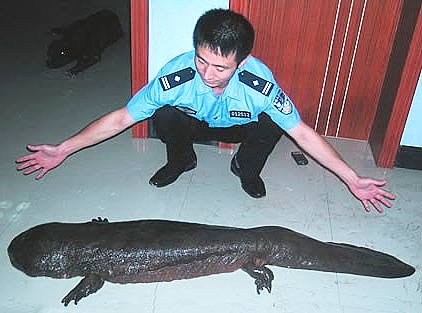Post by Ceratodromeus on Feb 4, 2017 4:20:50 GMT 5

Scientific classification
Kingdom: Animalia
Phylum: Chordata
Subphylum: Vertebrata
Class: Amphibia
Order: Caudata
Family: Cryptobranchidae
Genus: Andrias
Species: A.davidianus
Biology
The Chinese giant salamander (Andrias davidianus) is the largest salamander in the world, reaching a length of 180 cm (6 ft), although it rarely – if ever – reaches that size today. Endemic to rocky mountain streams and lakes in China, it is considered critically endangered due to habitat loss, pollution, and over-collecting, as it is considered a delicacy and used in traditional Chinese medicine. Records from Taiwan may be the results of introductions. It has been listed as one of the top-10 "focal species" in 2008 by the Evolutionarily Distinct and Globally Endangered (EDGE) project.
It has a large head, small eyes and dark and wrinkly skin. It is one of only two extant species in the genus Andrias, the other being the slightly smaller, but otherwise very similar Japanese giant salamander (Andrias japonicus). The Chinese giant salamander feeds on insects, frogs, and fish. It has very poor eyesight, and therefore depends on special sensory nodes that run in a line on the creature's body, from head to tail. They are capable of sensing the slightest vibrations around them with the help of these nodes. The female lays 500 eggs in an underwater breeding cavity, which is guarded by the male until the eggs hatch after 50–60 days. The average adult salamander is 25–30 kg (55-66 lb) and 1.15 m (3.8 ft).

The giant salamader is known to vocalize, making barking, whining, hissing, or crying sounds. Some of these vocalizations bear a striking resemblance to the crying of a young human child, and as such it is known in the Chinese language as "infant fish" (娃娃魚 / 鯢)
In captivity
A medium-sized specimen, approximately 3 ft (0.91 m) long, was kept for several years at the Steinhardt Aquarium in San Francisco, California, and now is on display again in the "Water Planet" section of the new California Academy of Sciences building. As of early 2008, ISIS records only show five individuals held in US zoos (Zoo Atlanta, Cincinnati Zoo, and Saint Louis Zoological Park), and an additional four in European zoos (Zoo Dresden and Rotterdam Zoo). It is likely additional individuals are kept in non-ISIS zoos and animals parks in its native China. There are several of them in the aquarium of Shanghai. This salamander is also kept in the Xian aquarium. It has been bred in captivity, but it is doubtful if this can be achieved to an extent where the pressure on the wild populations is reduced.
Original author
animaliaenthusiasts.proboards.com/user/3


